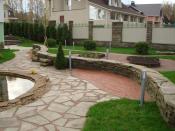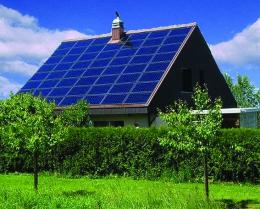Search
Login
Solar panels for summer cottage. Modern engineering systems
At present, during the period of the global economic crisis, the issue of alternatives for energy production is becoming more and more urgent. Increasingly, people turn to the energy of the sun.
Content
- House project for installing solar panels
- House Engineering Systems
- Network outage
- Solar Electricity
- Earth heat use
- Explanationvideo
It’s inherent in a person to live in a beautiful place, and we, in Russia, have a lot of beautiful places, but the question is that there is no gas and is not expected in the future, there is no electricity, and if it is not always. And I want to live in comfortable conditions. And while the gas is not supplied, purchase the eurowood from LLC RUF RUF. Eurodrove have a constant burning temperature, burn for a long time. The result of using such firewood is minimal fuel consumption and the absence of harmful substances. We can say that this is the best replacement for blue fuel. But progressive masters turn their eyes to heaven, deciding to put the sun energy at their service.
House project for installing solar panels
We invite you to consider the project of life support at home using solar panels and a heat pump.

When designing a house, it is necessary to provide a separate room where equipment can be placed to maintain the functioning of solar panels and a heat pump. During the construction of the house itself, it is necessary to build the house in such a way that the sun's rays fall on the module located on the roof, the longest period of daylight hours.
The building is installed in such a way that the roof slope on which the photovoltaic modules that absorb solar energy will be mounted is directed to the south. In addition, the roof of the structure should be of such a size that it was possible to place on it such a number of photovoltaic modules, the energy reserve of which would be sufficient for house maintenance. The slope of the roof must have a certain degree.

All this must be taken into account when developing the project, in addition, it is necessary to take into account the features of the area and climate. When creating a project, the wishes of the host customers are taken into account to determine the future energy consumption of the entire house. It is good to build the house itself with the use of all heat-saving materials, the latest technologies, use all methods to save and provide heat to the house.
House Engineering Systems
According to the project, equipment necessary for a comfortable life should be installed in the house: kitchen appliances, washing machine and dishwasher, refrigerator, TV.

The operability of all this equipment, including full lighting at home, should be ensured by solar panels.
Home heating should be provided by a heat pump.
Moreover, the heating of the first floor is provided by warm water floors, and the second floor by water convectors.

The heat pump according to the project consumes up to 2 kW. energy and connected to the backbone networks. As a result of the development, the house received almost autonomous power, with the exception of heating.
Network outage
In the event of a power outage, for emergency maintenance of such a house, an uninterruptible power system (SPB) is provided.
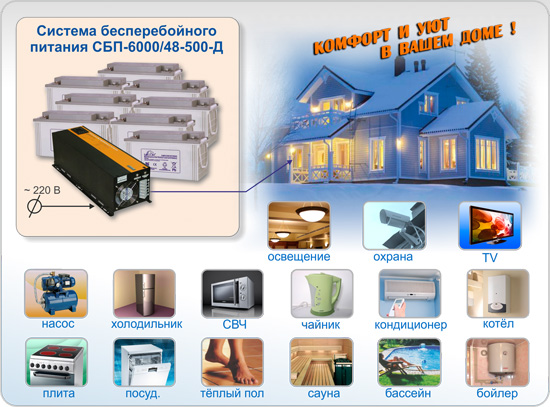
Such a system is convenient in that when there is power supply to the mains, it passes the mains voltage to the load, while its charger simultaneously charges the battery pack.
When the power is disconnected from the mains, SPB switches to battery operation and converts direct voltage to alternating voltage, ensuring uninterrupted operation of electrical appliances.

Thus, the uninterruptible power supply system provides not only a backup and emergency power supply mode, but also an autonomous operation mode.
SPB in operation is much better than any generator, and since the system works not only from the mains network, but also from alternative sources of electricity to which it is connected using the controller, it is necessary.

Currently, this home energy supply system is very efficient.
Solar Electricity
When erecting the walls of a house, for solar panels to work, it is necessary to lay power cables that connect the roof-mounted photovoltaic modules to the service system (this includes batteries, a battery charging controller, an inverter or a voltage converter).
All this is convenient to do at the stage of building a house.
Depending on the load, power consumption, the number of photovoltaic modules is calculated. The basis is the average daily energy consumption in kW / h.
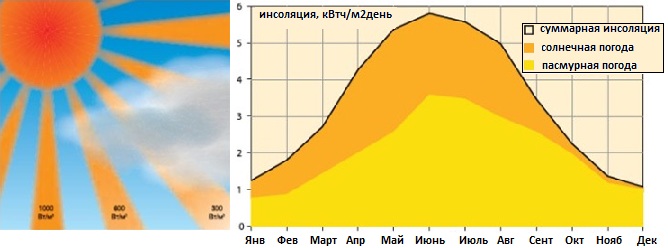
To determine the number of photovoltaic modules, you need to know: the energy consumption of the object, the power of the module, the insolation coefficient for a particular area.
The insolation coefficient is a measure of the energy of solar radiation received at a given area of \u200b\u200bthe earth’s surface at a given time.
It shows the efficiency of the sun at a given time of the year.
This coefficient is calculated on the basis of statistical observations, taking into account the number of sunny and cloudy days, the seasonal duration of daylight hours. Such data are available on the Internet or in special publications that publish solar insolation maps.
If the house is designed for year-round use, the number of photovoltaic modules is determined based on the worst weather conditions, i.e. period of time with the lowest seasonal rate of insolation. That is, the lower the insolation coefficient, the more modules are mounted.
Modules are mounted on the roof using special aluminum mounts; these mounts are universal, suitable for installation on a sloping roof and on a horizontal surface.
Equipment serving system (batteries, controllers, inverters) is placed inside the house.
Earth heat use

1. The heat exchanger transfers the heat of the earth to the inner circuit.
2.Compressor
3. Heat exchanger of heat transfer of the internal circuit to the heating system
4. Throttle device
5. Brine circuit and earth probe
6. Heating circuit
To take a piece of heat from the earth, you need a heat pump.
Even at the stage of excavation, at a depth of 3 meters, under the foundation, pipes are laid that form a circuit, they are brought to the surface in such a way as to connect to the equipment installed in the house.
The heat pump works offline, takes up little space, works about the same as a refrigerator. The heat pump is equipped with an evaporator, compressor, condenser, throttling device.
It differs from a conventional refrigerator only in the settings. Freon is selected so that it can boil even at subzero temperature, this steam is drawn into the compressor, where it is compressed.
At the same time, its temperature rises to 100 degrees Celsius. Then the hot and compressed freon is sent to the condenser heat exchanger, where it is cooled by water or air.
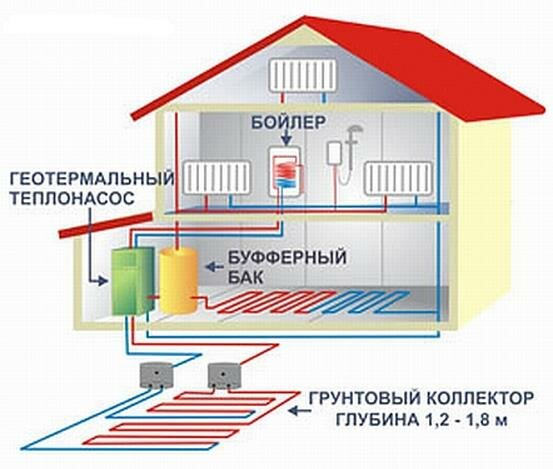
On cold surfaces, steam condenses, turns into a liquid.
The water heated in the heat exchanger is sent to the heating system.
According to this project, the water passes through the underfloor heating system, heats the air in the ground floor room. Then again, liquid freon is sent to the throttle valve, and then returns to the evaporator again. The cycle has ended and will automatically repeat while the compressor is running.
Explanation
1. The solar module. The energy of the sun is converted into electric energy using the semiconductor-silicon. In this case, direct current is generated, which with the help of an inverter can be converted into alternating current, or use this energy directly with various direct current loads.

2. The controller is the main element of control and management of the entire power supply system. Its main task is to fully charge the battery, avoiding overloads or reverse current at night. The controller provides complete security, ensures the operation of the entire solar power system.
3. Battery - energy storage. In uninterruptible power systems, there are several types of batteries.

4. The inverter is a DC voltage converter from batteries or solar panels, fuel and other generators to a voltage of 220 volts, 50 hertz

